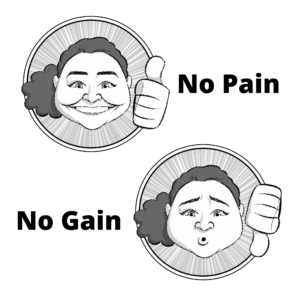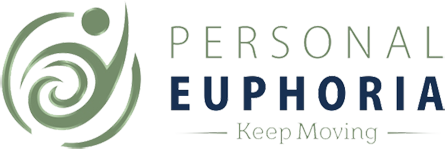 We’ve all heard the phrase, No Pain, No Gain in relation to exercises. It’s a popular expression but it is not true. Actually, it’s potentially harmful.
We’ve all heard the phrase, No Pain, No Gain in relation to exercises. It’s a popular expression but it is not true. Actually, it’s potentially harmful.
When we think No Pain, No Gain in terms of exercise we tend to think that either our workout should be grueling, or we should be sore the day or two afterward. If we aren’t then we presume we haven’t done enough. The problem is working out and pushing through pain increases our risk of injury. Once we are injured our whole workout plan can be derailed. Plus the Delayed Onset Muscle Soreness (DOMS) we feel 24-48 hours after a workout isn’t practical or functional. We are more likely to get injured then because we have to alter the way we naturally move to work around how sore we are.
While you can choose to only do an upper body workout every other day, you can’t not use half your body for a whole day. We need our arms to pick up our children, reach for something off the top shelf, and open the refrigerator. We need our legs to go upstairs, get in and out of the car, and get on and off the toilet. When we are sore from a workout, we just struggle the next couple of days. But what do we really gain?
So Why Do We Believe No Pain, No Gain?
It’s hard to change ingrained ideas and long-held beliefs. This one has been around a long time. Ben Franklin used to say, “No Gains without pains.” He wasn’t always referencing exercise, but the message crept into fitness. Then in the 70’s Jane Fonda popularized the catchphrase. It also rhymes and we are more likely to believe rhymes. It’s a marketing tool.
Also, many people believe that in order to build muscle we have to injure our muscles so that the body can repair the muscle. That is how we build muscle, right? While that’s one way, we have known for 20-years that you don’t have to injure the muscle in order to make muscular gains. In a study comparing two groups of exercises—one who pushed until they were sore and another who built up more gradually and never experienced DOMS—both groups made the same muscular gains. It took the gradual group three weeks longer, but they got to the same result.
We see athletes pushing to extremes and certainly working until they are sore, but they have an entire team of massage therapists and physical therapists to help support their recovery. They are often trying the most new-fangled ideas for healing injuries and they are often nursing and attempting to ward off injuries.
For most of us, there is just no benefit to push to that point and suffer for it. We also know that it’s not ideal to create inflammation in the body every day, especially if it’s not necessary. And, again, if we wind up injured or just not finding moving pleasurable because it hurts, we won’t want to do it.
What is Enough?
As a fitness instructor, it is much easier for me to design a workout for someone who wants to feel sore afterward than to hone a workout so someone gets enough challenge without suffering for a day or two afterward. To make someone sore, we need heavy weight, high reps, and eccentric contraction, because the types of moves you do determine, in part, how sore you will be. Also, certain muscles groups are more likely to get sore more easily. And genetics plays a role too. Some people will feel sore faster than others. Soreness is not a really good indicator of quality, good movement.
How do you know if you’ve done enough if we can’t tell based on how sore we are afterward? We all need to listen to our bodies better. It is okay to have gentle workouts that just feel good. But if you do want to make gains, you can still challenge yourselves. It’s not that you can’t work until a muscle is tired or feeling like it’s working. You just need to stop before that challenge becomes painful, or you notice your form starts to get sloppy. If you start to feel fatigued—you are physically exhausted or you feel your knees start to buckle. Upon feeling fatigued we are trained to think this is when to push and this is when we make all our gains. In fact, the brain is trying to protect you from injury. It’s trying to give you the signal to stop. We should listen.
We are more likely to exercise if we feel good. Years ago a friend of mine made herself run because she thought it was good for her, but she never enjoyed it. Then someone told her to slow down and run at a pace that feels good. Suddenly running was much more pleasurable. We have to give ourselves permission to listen to pain and stop or alter what we are doing.
In the long run, we will make the same gains and be far more likely to stick to our workout. The truth is No Pain, All Gains. Or, if we want another rhyme to trust in: Listen to your brain, stop when there’s pain. Because we can all make progress without pain.
Check out Maggie’s segment on CT Live here: https://www.youtube.com/watch?v=6yb_GF5axvU
Keep Reading
Read about how to do a lunge properly!
Check out this similar blog about chilling out for better results!
Keep Connected
Order Your Copy of Keep Moving Today!
Subscribe to the Keep Moving Blog
Like the Personal Euphoria Facebook page
Find us on Twitter
Follow me on Instagram
Subscribe to my YouTube Channel
